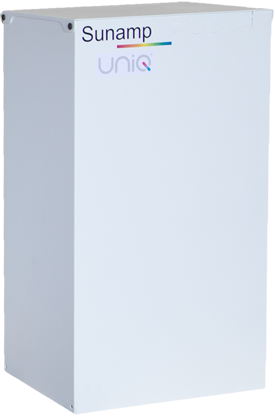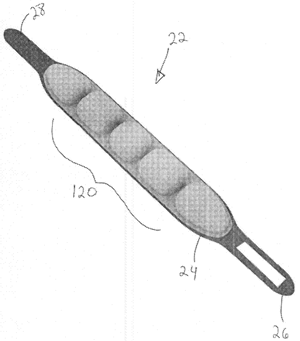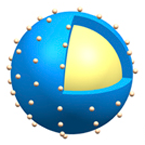 The Phase Change Matters e-mail newsletter is a weekly summary of the latest news and research on phase change materials and thermal energy storage. To subscribe, visit www.puretemp.com/subscribe. For more frequent updates, follow @puretemp on Twitter or visit the Phase Change Matters blog, www.puretemp.com/pcmatters.
The Phase Change Matters e-mail newsletter is a weekly summary of the latest news and research on phase change materials and thermal energy storage. To subscribe, visit www.puretemp.com/subscribe. For more frequent updates, follow @puretemp on Twitter or visit the Phase Change Matters blog, www.puretemp.com/pcmatters.
Sunamp signs agreement with Chinese heat pump maker
Sunamp Ltd. of Scotland has signed a memo of understanding with a Chinese manufacturer to develop a heat pump water heater for the residential market.
 The new technology will combine heat pumps made by Jiangsu Gomon Renewable Energy Development Co. and Sunamp’s UniQ heat batteries, which use a salt-based phase change material to store excess energy generated by solar PV systems. The stored energy is released on demand to provide heat and hot water.
The new technology will combine heat pumps made by Jiangsu Gomon Renewable Energy Development Co. and Sunamp’s UniQ heat batteries, which use a salt-based phase change material to store excess energy generated by solar PV systems. The stored energy is released on demand to provide heat and hot water.
The two companies signed the agreement this week at the ISH trade fair in Frankfurt. The agreement sets the terms for manufacturing and marketing the product in China and worldwide. Sunamp says product testing is already underway.
“Sunamp aims to displace as many water tanks as possible with UniQ heat batteries,” said Maurizio Zaglio, Sunamp’s international business development manager. “The fact that one of the largest manufacturers of water tanks in the world has decided to develop a new product with us is an important milestone for Sunamp.”
In a presentation at ISH, Zaglio put it more plainly: “We are not here to complement hot water tanks – we are here to replace them!”
The deal is Sunamp’s second with a major Chinese manufacturer in the past four months. In November, the company signed an agreement with Trina Solar to develop an integrated solution combining Sunamp heat batteries now made in Scotland with heat pumps manufactured at Trina’s new factory in Changzhou, China.
PATENTS
Dimensionally stable phase change material
U.S. patent application 20190078006 (applicant Microtek Laboratories Inc., Dayton, Ohio):
“Methods for producing a dimensionally stable phase change material (PCM), and dimensionally stable PCMs are disclosed. The methods include providing a porous base material, mixing a phase change material having a polar functional group with a substance that increases the polar attraction of the phase change material for the porous base material to form a mixture thereof; and, thereafter, mixing the mixture with the porous base material until a selected saturation of phase change material in the porous base material is reached. The methods may include filtering the porous base material after the selected saturation is reached to form a cake of dimensionally stable PCM and, thereafter, reducing the size of the dimensionally stable PCM to an average mean particle size of about 10 to about 50 μm, or more preferably 20 to 30 μm.”
Gas turbine engine having a heat absorption device
U.S. patent application 20190078516 (applicant General Electric Co., Schenectady, N.Y.):
“A gas turbine engine having a heat absorption device and an associated method are disclosed. The gas turbine engine includes a compressor, a combustor, a turbine, a bleed fluid cavity, and the heat absorption device. The combustor is coupled to the compressor. The turbine is coupled to the compressor and the combustor. The bleed fluid cavity is formed at a first predefined location in the compressor. The heat absorption device is disposed in the bleed fluid cavity and includes a casing, a flow path, and a phase change material. The casing includes an inlet and an outlet. The flow path is within the casing, extends between the inlet and the outlet, and directs an input bleed fluid separated from a fluid stream discharged from the compressor. The phase change material is filled in the casing, separated from the flow path.”
 Personal cooling system
Personal cooling system
U.S. patent application 20190076293 (inventor Hillel Zakai, Teaneck, N.J.):
“A personal cooling system for maintaining an individual at a preferred predetermined temperature in the outdoor environment of a venue, for an extended period of time, according to one embodiment includes a first cooling element comprising a phase change material (PCM) and at least one cooling station for providing any one of an additional one or more frozen cooling elements, each having a PCM, and at least one freezing medium for freezing any of said cooling elements. The cooling station is installed at the venue.”
One-piece insulating container
U.S. patent application 20190077576 (inventors Drayton G. Miller, Dauphin Island, Ala., and William J. Gunn, Springfield, Ill.):
“A one-piece cushioning and insulating container and insulation template for forming the container are provided. The insulation template includes a case blank and an insulating member secured thereto. The template may be formed into a three-dimensional container that provides cushioning and insulating items contained inside the container by simultaneously folding the case blank and insulating member. The template is designed to provide a completely enclosed space that is cushioned and insulated on all sides. The dimensions of the template may be adjusted to create containers of varying dimensions. The container may be constructed of various materials with a layer of soft, flexible material secured therein. The template may have heating or cooling elements, including phase change materials, incorporated into insulating member.”
Mobile lab for rapid detection and analysis of biological targets
U.S. patent application 20190076844 (applicant MRIGlobal, Kansas City, Missouri):
“A mobile field-deployable laboratory to more conveniently enable the detecting, sequencing and analyzing of biological agents at the point-of-need. This device enables field operators to go from sample to actionable information in the field without the need for an internet connection or grid-based power. … [The] cooling system includes a phase-change cooling system capable of holding a predetermined selected temperature constant for a predetermined time period.”
IN BRIEF
• A training school on thermal energy storage material selection, optimization and characterization will be offered May 20-21 at the University of Barcelona. The university’s Center for Design and Optimization of Processes and Materials is hosting the event. The fee is 230 euros. Lecturers include Camila Barreneche, Ana Inés Fernández, Mercè Segarra and Pablo Gamallo of the University of Barcelona; Luisa Cabeza and Alvaro de Gracia of the University of Lleida, Spain; and Yulong Ding of the University of Birmingham, United Kingdom.
• Alexium International Group Ltd. was among the companies making presentations this week at the Gabelli & Company Specialty Chemicals Conference in New York City. Alexium, based in Greer, S.C., and Perth, Australia, makes flame-retardant and PCM-enhanced fabric treatments. Among its “cornerstone” initiatives is a plan to launch a new product line in early 2019, Alexicool FM, the application of the company’s Alexicool technology to foam mattress and “top of bed” products.
• Thermal materials specialist va-Q-tec reports that its annual revenue grew by 8 percent in 2018. The company, based in Würzburg, Germany, said sales from its products business, including vacuum insulation panels and phase change materials, increased by 12 percent to 20.1 million euros, up from 18 million euros in 2017. However, its earnings fell by 58 percent, to 3 million euros. It blamed earnings decrease on investment costs and a rise in sales from its lower-margin products business.
• Australian researchers are challenging the belief that 22° C (72° F) is the optimum temperature to maintain worker productivity. A team from Griffith University’s School of Engineering and Built Environment and Cities Research Institute performed an extensive review of research literature on the relation of moderate thermal environment to cognitive performance. “From the research point of view,” the lead researcher, Fan Zhang, said in an interview with the Cooling Post, “there is no empirical evidence that this temperature [22ºC] should be maintained. In effect, it is inconsistent with the already-established comfort benchmarks such as ASHRAE 55-2017, which recommends a summer time thermal comfort zone of 23-26ºC. I would say 23-26 is a safe summer temperature set point range for western developed countries.”
RESEARCH ROUNDUP
For our full list of recent academic research, see puretemp.com/academic. Here are highlights from the past week:
From International Journal of Refrigeration:• Experimental study of enhanced PCM exchangers applied in a thermal energy storage system for personal cooling
 From Journal of Materials Research:
From Journal of Materials Research:• Fabrication and characterization of microencapsulated n-octadecane with silk fibroin–silver nanoparticles shell for thermal regulation
From IOP Conference Series: Earth and Environmental Sciences:
• Simple Thermal Energy Storage Tank for Improving the Energy Efficiency of an Existing Air-conditioning System
• An optimization study into thermally activated wall system with latent heat thermal energy storage
• Simulation of operation performance of a solar assisted ground heat pump system with phase change thermal storage for heating in a rural building in Xi’an
• Experimental Study on the Demand Shifting Effects of PCM Integrated Air-Conditioning Duct
From International Journal of Energy Research:
• Efficiency optimisation of the thermal energy storage unit in the form of the ceiling panel for summer conditions
From Materials Research Express:
• Experimental study on thermal conductivity of composite phase change material of fatty acid and paraffin
From Energies:
• Design Optimization of a Hybrid Steam-PCM Thermal Energy Storage for Industrial Applications
From Construction and Building Materials:
• Analysis of thermoregulation indices on microencapsulated phase change materials for asphalt pavement
From Applied Thermal Engineering:
• Experimental and numerical characterization of an impure phase change material using a thermal lattice Boltzmann method
From Energy Conversion and Management:
• Experimental and numerical study of a vertical earth-to-air heat exchanger system integrated with annular phase change material
From Materials:
• Thermal and Structural Characterization of Geopolymer-Coated Polyurethane Foam—Phase Change Material Capsules/Geopolymer Concrete Composites
From Applied Sciences:
• Microstructure and Mechanical Properties of Cement Mortar Containing Phase Change Materials
NETWORKING
Connect with PCM experts and industry leaders on LinkedIn
 More than 1,400 people have joined a LinkedIn group devoted to the discussion of phase change material and thermal energy storage. The Phase Change Matters group is an interactive complement to the award-winning blog and newsletter of the same name.
More than 1,400 people have joined a LinkedIn group devoted to the discussion of phase change material and thermal energy storage. The Phase Change Matters group is an interactive complement to the award-winning blog and newsletter of the same name.
You are invited to join the group and connect with PCM and TES experts from around the world. This week we welcome Tara Kelley, operations and project management, Viking Cold Solutions Inc., Houston; David Nolan, sales engineer at Pennine Environmental Services Ltd., Liverpool, United Kingdom; and Michael Ting, research and development engineer at Serta Simmons Bedding LLC, Atlanta, Georgia.